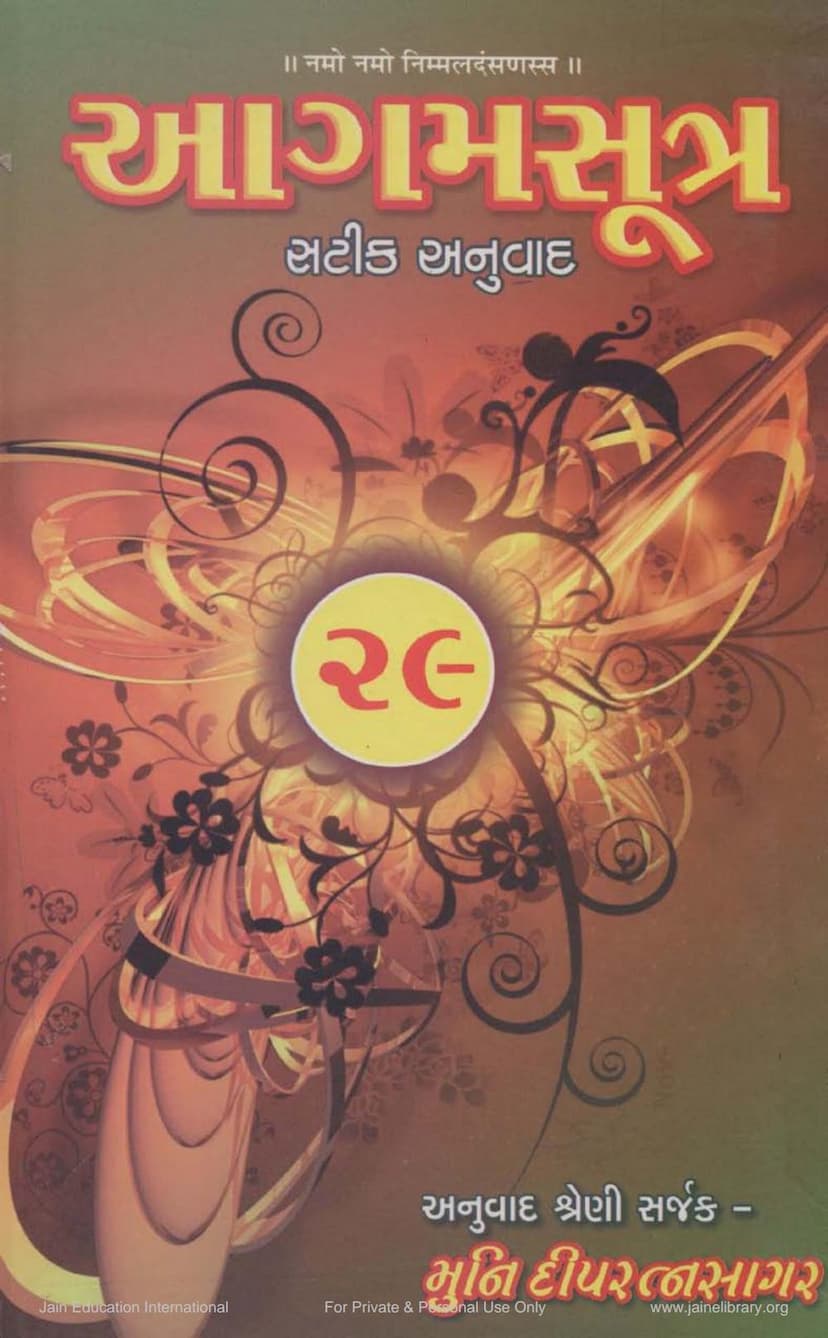Agam 37 Dashashrut Skandha Sutra Satik Gujarati Anuvad
Added to library: September 1, 2025

Summary
This document is the Gujarati translation and commentary (Satik Anuvad) of Agam 37, the Dashashrut Skandha Sutra. The publication is part of a larger series of forty-two volumes titled "Agam Sutra Satik Anuvad," compiled by Muni Dipparatnasagar and published by Deepratnasagar.
Key aspects highlighted in the provided pages:
-
The Series: The series aims to provide a comprehensive translated and commented version of the Jain Agamas. This particular volume, "Agam 37 Dashashrut Skandha Sutra," is identified as the 29th part of this extensive project.
-
The Sutra: The Dashashrut Skandha Sutra is identified as the fourth of the five "Ched Sutras" (foundational texts concerning discipline and conduct). The other Ched Sutras are Nishith, Vyavahar, Brihatkalpa, and Jitakalpa.
-
Content of Dashashrut Skandha: The text focuses on explaining the core principles and rules for monks and nuns. Specifically, it details:
- Dasha 1: Asamadhishthan (Non-concordance/Trouble Spots): 20 points outlining minor faults or situations that disrupt peace and harmony in the monastic life.
- Dasha 2: Sibal Dosh (Serious Faults): 21 more serious faults that are detrimental to spiritual progress, including issues related to food, conduct, and adherence to rules.
- Dasha 3: Ashatana (Disrespect/Dishonor): 33 instances of disrespect or improper conduct towards senior monks or those with greater spiritual knowledge.
- Dasha 4: Gani Sampada (Qualities of a Leader/Head Monk): Describes the eight essential qualities of a monastic leader, including mastery of conduct (Achar), scripture (Shrut), speech (Vachan), and intellect (Mati), among others. It also outlines the duties of an Acharya towards their disciples and the responsibilities of the disciples towards their Guru.
- Dasha 5: Chitta Samadhi Sthan (States of Mental Tranquility): Explains ten states that lead to mental peace and spiritual advancement, often achieved through various forms of knowledge (like Avadhijnana, Manahparyavajnan, Kevaljnana) and adherence to the path of liberation.
- Dasha 6: Upasak Pratima (Lay Follower Vows): Details eleven stages or vows for lay followers (Upasak) who are unable to fully embrace monastic life but wish to progress spiritually through progressive stages of religious practice and renunciation.
- Dasha 7: Bhikshu Pratima (Monastic Vows/Stages): Outlines twelve stages or vows for monks, detailing their conduct, dietary practices (e.g., taking one datti of food/water), movement, and various forms of penance and renunciation, with specific timeframes for adherence to each stage.
- Dasha 8: Paryushana: Briefly mentions that this section relates to the Paryushana (festival of fasting and repentance) and the life of Lord Mahavir, connecting it to the Uttara Phalguni constellation. It notes that this section in Dashashrut Skandha is brief and the true essence lies in its extensive commentaries.
- Dasha 9: Mohaniya Karma (Deluding Karma): Explains thirty causes or actions that lead to the bondage of Mohaniya Karma, which obstructs spiritual progress and leads to delusion and attachment. These causes range from violence and deceit to disrespect towards spiritual guides and adherence to wrong beliefs.
- Dasha 10: Ayati Sthan (Causes of Rebirth/Bondage): Discusses various actions and desires that lead to continued transmigration in the cycle of birth and death (samsara). This section details the motivations of monks and nuns that can lead to unfavorable rebirths, including the desire for worldly pleasures, power, or even the aspiration to attain specific divine states, which can still be considered "nidana" (unfulfilled desires that bind one to the cycle). It emphasizes the importance of pure intention and detachment from worldly or even divine enjoyments for true liberation.
-
Commentary Style: The translation includes explanations, clarifications, and the meaning of specific terms, making the complex Jain scriptures accessible to a wider audience.
-
Support and Acknowledgments: The initial pages include extensive acknowledgments of donors and spiritual guides who supported the publication of this series, highlighting the collaborative effort involved. It also lists other publications by the same author/publisher related to Jain Agamas and literature.
-
Purpose of Ched Sutras: The introduction notes that these Ched Sutras are primarily considered works on penance and atonement. Nishith deals with offenses and their expiation, Brihatkalpa with various regulations, Vyavahar with the conduct of monks and nuns, Dashashrut Skandha with states of peace and stages of practice, and Jitakalpa (or Panchakalpa) with expiation and faults.
In essence, this volume of the Dashashrut Skandha Sutra provides a detailed exposition of the principles of Jain monasticism and lay practice, outlining ethical guidelines, disciplinary rules, and the psychological states that contribute to or hinder spiritual progress, all explained with commentary for understanding.